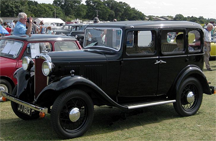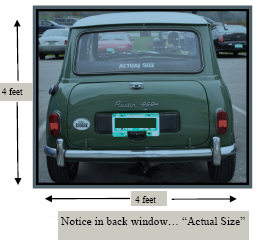 Hillman is a name not well known in the automotive field anymore. Hillmans are British and like most British manufacturers of automobiles, the Hillman Motor Car Company is defunct. The last Hillman imported into this country was the Super Minx of the mid 1960s. The company was still being run by Lord Rootes, a founder, at the time. The Hillman Motor Car Company began in 1907. Previous to that, the company had made sewing machines and bicycles. Hillman played a role in pioneering the American automobile market, opening doors for other makes back in the days when those funny foreign cars drove a lonely road in this country.
Hillman is a name not well known in the automotive field anymore. Hillmans are British and like most British manufacturers of automobiles, the Hillman Motor Car Company is defunct. The last Hillman imported into this country was the Super Minx of the mid 1960s. The company was still being run by Lord Rootes, a founder, at the time. The Hillman Motor Car Company began in 1907. Previous to that, the company had made sewing machines and bicycles. Hillman played a role in pioneering the American automobile market, opening doors for other makes back in the days when those funny foreign cars drove a lonely road in this country.
Hillman had been importing small sedans since before World War II, but after the war, the small car market became more competitive. To get a leg up in styling, Lord Rootes hired the designer Raymond Lowey (think Studebaker Hawk of 1953) in 1948 to design a new car. Thus came about the shaping of my car, which takes styling cues from the 1953 Studebaker and the 1955-56 Ford. To further compete in the American market, Rootes sought a technical advantage as well. After all, some American manufacturers were starting to build “compact” cars, bidding for sales with fresh new packages. Consider the Ford Falcon or the Chevy Corvair. In 1960, Hillman was offering a product that no one else had-a fully automatic transmission that did away with the power loss associated with ordinary automatic transmissions of the day. Acceleration of a Hillman does not suffer as a result of the Easidrive option. This was important in 1960 because thousands of drivers in this country didn’t want small cars because of the bother of shifting gears manually. The Easidrive was a significant small car development in the days of oversized Detroit sedans and small, slow American cars optionally equipped with automatic transmissions.
I bought my car in 2002 from an antiques dealer in Wiscasset, Maine. It had been acquired by him as part of an elderly man’s estate. It had 40,000 miles on it then and I have taken it 24,000 sort-of carefree miles since then. My initial test drive of the car did not inspire confidence. Looking behind the steering wheel I noticed it had….an automatic transmission? I had always feared foreign automatics of the post-war generation since they could be weird and prone to trouble. Oh well, the car did start right up and sounded solid and quiet. The gear selector quadrant is minimalist in nature: D 2 N R in that order. There is no P position and I assumed the handbrake was a dubious instrument as evidenced by the rock placed behind the rear wheel. The car moved forward in D but would not shift into a higher gear. I stopped and gave it another try. This time, at about 15mph, I lifted my foot off the throttle and heard a distinct “clunk” and then we were in 2nd gear. At about 27mph the car shifted automatically into 3rd which felt like top gear. I could live with this. I came to a full stop and tried reverse. There was a slight grinding of gears to be heard as I shifted the lever. What the hell kind of automatic was this???
Thus begins the tale of what makes this car different. Here in layman’s terms is the Easidrive story. Remember the science experiment back in elementary school in which iron filings placed on a piece of paper were arranged in lines of magnetic flux by a magnet placed beneath the paper? If you can visualize that experiment, you have the basic idea of Easidrive. Easidrive uses a magnetic powder coupling in place of a friction clutch. The transmission itself is a regular sliding gear type 3 speed transmission. Imagine a drum bolted to the flange on the rear of the crankshaft. Then, imagine a slightly smaller drum which fits inside the aforementioned drum and is connected to the transmission input shaft. These drums are separated by a small air gap filled with an amount of iron powder. In neutral, as the crankshaft turns, this powder is thrown harmlessly by centrifugal force against the inside of the outer (crankshaft) drum. Now surround these drums with a stationary magnetic coil mounted in the transmission’s bell housing. When this coil is energized, the iron powder organizes itself in columns of magnetic flux between the two drums, forming a solid coupling between the engine and transmission. The advantage to such a coupling is that there is little or no slippage. There is no hydraulic torque converter to waste power, an important consideration in a 57 hp, 2375 lb. car such as the Hillman. This represented a design coup, applying a fully automatic transmission to a 1500 cc car.
But the devil is in the details, of course. All this stuff under the floorboards is con-trolled by the troublemakers under the bonnet, or hood as we Yanks would put it. This trouble includes: an electric gear selector switch, a governor which monitors road speed and throttle position, a gearshift solenoid and a control unit (black box) which contains eight 2 way relays, a thermal switch and a rectifier. Maintaining this lot is no problem if you’re an electrical engineer, which I am not. Fortunately for me and my Minx, my brother is. All the above-mentioned electrical units are wired closed with lead seals from the factory. Even Hillman mechanics were not allowed to open them up and investigate what might be wrong inside. Units were tested and if found faulty, replaced. Even the experienced garage mechanic in the early 1960s had no idea what he was looking at when he got under the hood of an Easidrive Hillman Minx. It was just another weird foreign car that nobody, including the dealers, wanted to deal with. This contributed greatly to Hillman’s demise. As the Easidrive reputation spread, dozens of new Easidrive cars sat in dealers lots unsold for years.
My car has experienced burned relay points and a broken wire in the control unit as well as another broken wire in the governor. My brother was able to decipher its woes from among the 96 symptoms and numerous wiring diagrams featured in the Easidrive repair manual. We broke into the sealed units fearlessly and solved my Easidrive’s problems. It wasn’t easy. It took about 8 hours, but I’ve been lucky. Most Easidrives were converted to normal Hillman 4 speed manual transmissions or simply scrapped. And that’s a shame because it is a nice car on the road or in town. I’ve driven without trouble to Ohio and back for 3 different “Hillmans on Holiday” car events, cruising at 65 mph with no trouble. I only know of one other Easidrive in the country, in Washington state, which is still running. I doubt we’ll ever meet car to car.










 Following WWII, the British auto industry was under the mandate of “Export or Die”. As a result, the most popular imported cars in the States after the War were British. According to Ward’s Auto World, the British had a 96% share of the U.S. imported car market in 1952. Today it is less than 1%. Popular post-war British cars were the MG TD and the Jaguar XK120. When most “car people” think of British cars, sports cars come to mind. Indeed, at the British Invasion of Stowe car show, Austin Healeys, MGs and Triumphs are the most popular entries among the hundreds of cars that show up.
Following WWII, the British auto industry was under the mandate of “Export or Die”. As a result, the most popular imported cars in the States after the War were British. According to Ward’s Auto World, the British had a 96% share of the U.S. imported car market in 1952. Today it is less than 1%. Popular post-war British cars were the MG TD and the Jaguar XK120. When most “car people” think of British cars, sports cars come to mind. Indeed, at the British Invasion of Stowe car show, Austin Healeys, MGs and Triumphs are the most popular entries among the hundreds of cars that show up.